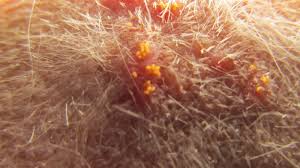WHAT ARE HARVEST MITES?
Harvest mites are a microscopic member of the same family as spiders,of the arachnids family. In the UK the mite that affects our pets is Trombicula autumnalis. Harvest mite larvae can be seen with the naked eye and can be something owners can look out for in their own pets, these mites can be easily recognised as bright orange dots, or orange dust like clusters.
Normally when the family pet picks up a few of these larvae in small quantities, pets may not even notice that they are on them. The problem occurs when the population starts to grow, and the larvae become more active, this is when we will start to see more clinical signs. These clinical signs are may include classic of dermatitis (skin inflammation), continuous rubbing/scratching, along with this, there may also be reddened areas patches of skin. There are also other signs that may be seen due to self-trauma of biting and itching.
The common places that the harvest mite larvae will be attracted to, are areas where the skin and coat is slightly thinner; commonly the paws, abdomen, groin, and the ears. In cats, the ear flaps are a common area that is affected, but they can be affected anywhere on the body.
THE LIFE CYCLE

DIAGNOSES OF HARVEST MITES
A sudden onset of itching around the months of July and August are suspicious of a harvest mite infestation. This, however, is not always the case as other ectoparasites and allergies such as pollen allergies may show very similar clinical signs.
When brought into the vet surgery, samples may be taken from affected areas and these samples will be examined under the microscope, to positively identify the harvest mite larvae. These samples may be taken by using e strips of sticky tape or hair by plucking hairs depending on the veterinary surgeon and the area that is infected.
The longer the problem goes on , the harder it will be to pinpoint the problem as the harvest mites may have matured and long gone leaving no residual signs,there may be no signs of harvest mites but a case of only non-specific signs of dermatitis with no clear and unknown origin.
TREATMENT OF HARVEST MITES.
In the UK there are no licensed products for treating harvest mites in dogs or cats. Even so there are treatments that can be prescribed by the veterinary surgeon that will kill harvest mites.Spot on treatments for fleas and ticks do not appear to kill harvest mites and spraying the affected area is the only effective way of removing them. The veterinary surgeon etc may also potentially prescribe medication to help with any excessive itching, particularly in cases where the this additional treatment may be due to the patient being shows signs of hypersensitivety to the harvest mite.
Where an animal is excessively itching, causing damage to the skin is a real possibility.W, where there is damage to the skin the animal also runs the risk of getting a bacterial infection, and other skin problems,. so some cases may warrant the use of topical antibacterial agents and or antibiotics These will be treated by the veterinary surgeon to affect that they feel is necessary.
To try and prevent cats getting harvest mites owners may also consider keeping cats inside during mite season. This season can run from July – September.
REDUCING THE EXPOSURE OF DOGS TO HARVEST MITES.
Walking dogs in the early morning or late evening has a lot of benefits during the warm months. It can help prevent heat stroke which is a potential life threating problem, burnt pads and also helps prevent the exposure of harvest mites.
As larvae are only active during the warm, dry days a good way of reducing the exposure of harvest mites is to walk dogs when it is cooler normally in the early morning or the late evening. Harvest mites are also been reported to be in very localised areas, meaning it is not uncommon to have masses of harvest mites in one field and none in the other.
Talking to other dog walkers or communicating on forums may be a really good way to find out about problem areas and avoiding these will also reduce exposure. Long grasses and thick vegetation are also prime areas that the harvest mite may be located as well as other ectoparasites such as ticks, so avoiding these may also be a good idea. If there is no reason to stop then keep moving, a lot of bad infestations are seen on dogs that are resting or sitting in a prone area in a hot day.
“
Harvest mite larvae can be seen with the naked eye and can be something owners can look out for in their own pets, these mites can be easily recognised as bright orange dots, or orange dust like clusters.”
CAN HARVEST MITES AFFECT HUMANS?
The harvest mite larvae will bite and feed on humans like any other warm blooded animals. These may be seen on the feet, ankles or lower leg. This can cause intensive itching but treating this with bite and sting cream normally settles the itching down. If you suffer from any other problems then contacting your GP is recommended. It is unlikely to have the clusters of harvest mite larvae on humans as they don’t have the amount of hair to attach to.
Even though the harvest mite larvae affects both humans and pets treatment that is given by the pharmacy or by the veterinary surgeon should NEVER be used on each other. Unless a veterinary surgeon specifically instructs the use of a human cream or medication.
By Rhys Dudley, SVN
Student Veterinary Nurse
